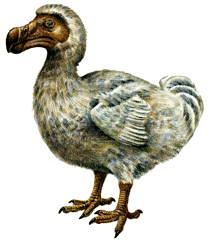DK Science: Extinction
Since life on Earth began, a huge number of animals have appeared, flourished and then disappeared again. These disappearances are called extinctions. Individual species become extinct for a variety of reasons, including competition and habitat changes. At least five times in the past there have been mass extinctions, where large numbers of animal species have died out in a short period.

Today, over-hunting is a major threat to many animals. In the past, it has contributed to many extinctions, including that of the dodo, a flightless pigeon from the island of Mauritius. Discovered in 1600, the dodo was easy to catch because it could not fly and was not afraid of humans. Sailors killed large numbers of dodos for food, and introduced animals such as rats, which destroyed their nests. By 1680, the dodo was extinct.
Dinosaurs became extinct 65 million years ago, at the end of the Mesozoic era. Their disappearance has been linked to a massive meteor strike, which left an vast crater beneath the Gulf of Mexico. Scientists think the gas and dust from this impact filled the atmosphere, blotting out the sun for centuries. In that time, 70 per cent of all animals died out, including the dinosaurs.
Many islands have unique species, found nowhere else. If new predators are introduced, they have no way of escaping. This makes them especially vulnerable to extinction. One way of protecting island animals is to make their homes nature reserves. This giant tortoise is from the Galapagos Islands, which are protected by the government of Ecuador.
Animals facing extinction in the wild can be saved by increasing their numbers in zoos. Pandas do not usually breed well in captivity, but in recent years the number of captive births has risen considerably. This is partly due to increased cooperation between zoos, with more loaning out their male or female pandas to form new pairs around the world.
